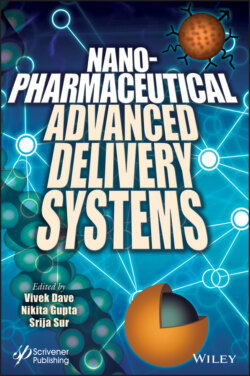Читать книгу Nanopharmaceutical Advanced Delivery Systems - Группа авторов - Страница 24
1.5 Challenges and Hurdles 1.5.1 Scale Up and Stability Issues
ОглавлениеThe development of the lipid-based nanocarrier system can easily be scaled using the reported approach for preparation. Several issues of stability can, however, be associated with lipid carriers and can be a hurdle in the process of the scale-up. Polymorphism must first be taken into account. The colloidal size and particularly their high volume-to-surface ratio can result in the decrease in melting points. This effect may also be caused by impurities, agents, and stabilizers [86, 87]. For example, the co-acervation and hot homogenization method of fatty acids and triglycerides results in polymorphism [88]. Due to rapid solvent evaporation, polymorphic forms have been obtained during spray drying.
Table 1.3 Different types of techniques used in the preparation of lipid nanocarriers.
| Preparation techniques | Description | References | |
| High-pressure homogenizationPressure: 100–2000 bar | Hot homogenization | Drug melted in hot lipid Pressure: 500–1500 bar Production of nanoemulsion | [78, 79] |
| Cold homogenization | Suitable for thermosensitive drug.Formulation rapidly cooled in dry ice. | ||
| Ultrasonication | Probe ultrasonication | Use for oral drug delivery systems.Diameter range: 80–800 nmReduce shear stress. | [80] |
| Bath ultrasonication | |||
| Solvent emulsification–diffusion method | Lipid dissolved in organic solvents (chloroform, ethyl acetate, methylene chloride, cyclohexane).Use for hydrophilic drug (w/o/w emulsion).Diameter range: 30–100 nm. | [81] | |
| Supercritical fluid method | Lipophilic substances dissolved in organic solvent.Nanoparticle range 25 nm.Solvent removal by evaporation (pressure 40–60 mbar). | [82] | |
| Microemulsion-based method | Two-phase system inner and outer (o/w microemulsion)Lower mechanical energy.Increased drug loading capacity, range of 200–250 nm. | [82] | |
| Spray drying method | Use for lipid with melting point more than 70°C.Alternative technique to lyophilization process. | [83] | |
| Double emulsion method | w/o/w two-step microemulsion technique.Drug is encapsulated with stabilizer to prevent leakage of drug. | [82] | |
| Precipitation technique | Glycerides dissolved in an organic solvent.Solution is emulsified in aqueous phase. | [84] | |
| Film-ultrasound dispersion | Form uniform size nanoparticles.Drug and lipid put in suitable organic solvent. | [82, 85] |
Furthermore, sterilization is an important stability parameter in lipid nanocarrier system production [89]. Irradiation is an existing technique of sterilization for pharmaceuticals. However, during irradiation, the chemical degradation of the lipids can occur: therefore, ionizing radiation is not allowed, or at least more tests are required before it is accepted as a safe and effective technique of sterilization. Diverse studies have preferred an autoclave approach because it doesn’t change the Zeta potential and mean particle size, although this is paradoxical considering the effect that temperature may influence the stability of nanoparticles.
Another significant cause for instability is phase separation [88] because of the formation of reversible or irreversible particles (coalescence, sedimentation); also during storage, gelling may occur. Adequate surfactants can be used to address these problems: they can stabilize LNP suspension by an electrostatic repulsion, which improves Zeta potential, or they can serve as steric (non-ionic surfactants) stabilizers. Surface stability, particularly electrostatic stabilization and Zeta potential, is highly sensitive to pH and eventually exists at the external phase, which may cause suspension destabilization.
The acquisition of solid water forms is an effective strategy for overcoming the problems concerning lipid nanocarrier storage stability. This can be achieved through spray drying or lyophilization of suspension.
Instability may occur in gastrointestinal fluids following enzymatic degradations of the particles or lipid matrix. Particle accumulation can be accomplished by improving the surfactant combination owing to ionic strength and acidic stomach pH. Stability conditions in combination with steric stabilization have been set at minimum 8–9 mV Zeta Potential [89].
Lipid nanocarriers have recently been investigated for their interaction with the major circulatory protein serum and albumin. Several groups of researchers also focused more and more on improving their body fluid stability through coating lipid nanocarriers with hydrophilic molecules like poly(ethylene)glycol (PEG) derivatives. Coating lipid nanocarriers with PEG improves stability and plasma half-life to suppress phagocytic uptake, thus improving drug bioavailability [90].
